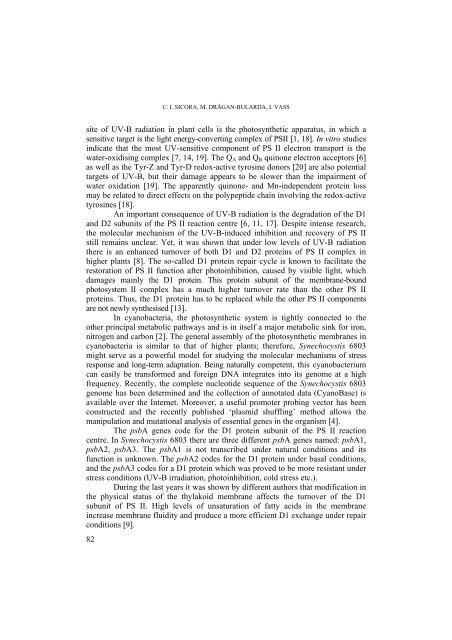studia universitatis babeÅ-bolyai biologia 2
studia universitatis babeÅ-bolyai biologia 2
studia universitatis babeÅ-bolyai biologia 2
You also want an ePaper? Increase the reach of your titles
YUMPU automatically turns print PDFs into web optimized ePapers that Google loves.
C. I. SICORA, M. DRĂGAN-BULARDA, I. VASS<br />
site of UV-B radiation in plant cells is the photosynthetic apparatus, in which a<br />
sensitive target is the light energy-converting complex of PSII [1, 18]. In vitro studies<br />
indicate that the most UV-sensitive component of PS II electron transport is the<br />
water-oxidising complex [7, 14, 19]. The Q A and Q B quinone electron acceptors [6]<br />
as well as the Tyr-Z and Tyr-D redox-active tyrosine donors [20] are also potential<br />
targets of UV-B, but their damage appears to be slower than the impairment of<br />
water oxidation [19]. The apparently quinone- and Mn-independent protein loss<br />
may be related to direct effects on the polypeptide chain involving the redox-active<br />
tyrosines [18].<br />
An important consequence of UV-B radiation is the degradation of the D1<br />
and D2 subunits of the PS II reaction centre [6, 11, 17]. Despite intense research,<br />
the molecular mechanism of the UV-B-induced inhibition and recovery of PS II<br />
still remains unclear. Yet, it was shown that under low levels of UV-B radiation<br />
there is an enhanced turnover of both D1 and D2 proteins of PS II complex in<br />
higher plants [8]. The so-called D1 protein repair cycle is known to facilitate the<br />
restoration of PS II function after photoinhibition, caused by visible light, which<br />
damages mainly the D1 protein. This protein subunit of the membrane-bound<br />
photosystem II complex has a much higher turnover rate than the other PS II<br />
proteins. Thus, the D1 protein has to be replaced while the other PS II components<br />
are not newly synthesised [13].<br />
In cyanobacteria, the photosynthetic system is tightly connected to the<br />
other principal metabolic pathways and is in itself a major metabolic sink for iron,<br />
nitrogen and carbon [2]. The general assembly of the photosynthetic membranes in<br />
cyanobacteria is similar to that of higher plants; therefore, Synechocystis 6803<br />
might serve as a powerful model for studying the molecular mechanisms of stress<br />
response and long-term adaptation. Being naturally competent, this cyanobacterium<br />
can easily be transformed and foreign DNA integrates into its genome at a high<br />
frequency. Recently, the complete nucleotide sequence of the Synechocystis 6803<br />
genome has been determined and the collection of annotated data (CyanoBase) is<br />
available over the Internet. Moreover, a useful promoter probing vector has been<br />
constructed and the recently published ‘plasmid shuffling’ method allows the<br />
manipulation and mutational analysis of essential genes in the organism [4].<br />
The psbA genes code for the D1 protein subunit of the PS II reaction<br />
centre. In Synechocystis 6803 there are three different psbA genes named: psbA1,<br />
psbA2, psbA3. The psbA1 is not transcribed under natural conditions and its<br />
function is unknown. The psbA2 codes for the D1 protein under basal conditions,<br />
and the psbA3 codes for a D1 protein which was proved to be more resistant under<br />
stress conditions (UV-B irradiation, photoinhibition, cold stress etc.).<br />
During the last years it was shown by different authors that modification in<br />
the physical status of the thylakoid membrane affects the turnover of the D1<br />
subunit of PS II. High levels of unsaturation of fatty acids in the membrane<br />
increase membrane fluidity and produce a more efficient D1 exchange under repair<br />
conditions [9].<br />
82

















